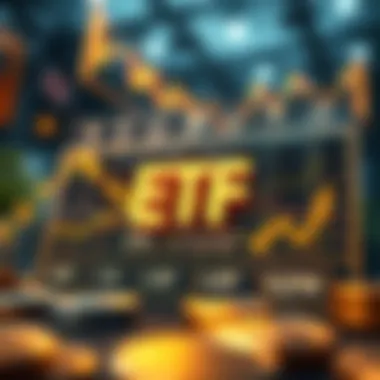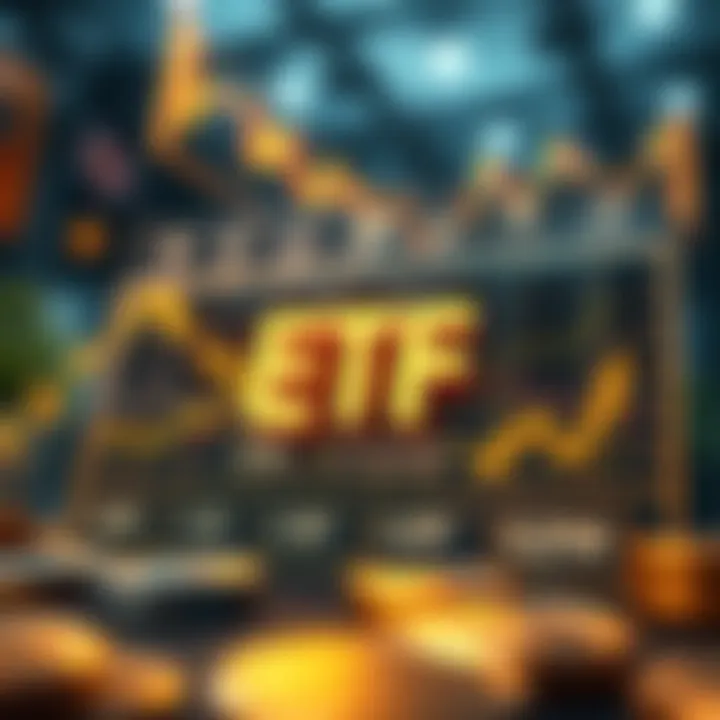Understanding ETFs: A Complete Guide for Traders


Intro
In the dynamic world of finance, Exchange Traded Funds (ETFs) have emerged as a cornerstone for investors seeking to amplify their portfolio diversity without the hassle of traditional investing methods. These funds offer a blend of the flexibility of stocks and the broad-market exposure akin to mutual funds. But what exactly makes ETFs tick? To answer this query, one must wade through the intricacies of their structure, potential advantages, and inherent risks. By grasping the mechanics of ETFs, traders can make more informed decisions, safeguarding their investments while chasing desired returns.
This guide will unpack the essentials of ETFs, digging into their various forms and illuminating the strategies one might employ to leverage them effectively. From understanding fundamental market trends to practical trading strategies, we will explore the landscape of ETFs to empower both novice and seasoned traders alike. So let's embark on this journey to demystify the world of ETFs and equip ourselves for smarter trading decisions.
Preamble to ETFs
Exchange Traded Funds, commonly known as ETFs, have reshaped the investment landscape, bringing with them a blend of accessibility, innovation, and efficiency. As these financial instruments gain traction among both seasoned traders and novice investors, understanding their essence and operation becomes vital for making informed choices.
Investors today are grappling with a range of options when it comes to alluding portfolios. ETFs stand out because they combine features of stocks and mutual funds; it’s like blending the best of both worlds. Investors can buy and sell them throughout the trading day, just as they would a stock. This liquidity brings a level of flexibility that is highly valued in today’s rapid-paced market.
Moreover, the increasing effort to diversify portfolios often leads investors to consider ETFs due to their broad market access. This encapsulates not only local stocks but also international markets and specific sectors.
This section sets the stage by defining ETFs and chronicling their evolution within financial circles. Understanding these aspects lays a strong foundation for grasping how ETFs function and their strategic importance for investors, traders, and anyone who wants to navigate the financial markets thoughtfully.
Defining ETFs
At its core, an ETF is an investment fund that trades on stock exchanges, much like individual stocks. It comprises a collection of assets, which could include stocks, bonds, commodities, or other securities. Operating as a basket of securities gives ETFs the inherent ability to provide diversification, reducing risk while simultaneously capturing a market segment's performance.
Investing in an ETF is simpler than it might seem; think of it as purchasing a share of a mini-portfolio, wherein each share represents a piece of that diversified basket. For instance, if an ETF tracks the S&P 500, buying one share gives you exposure to 500 different companies, rather than just putting your eggs in one basket.
Furthermore, ETFs are typically passive investment strategies, meaning they seek to replicate the performance of their underlying index, rather than trying to outperform it. This hands-off approach usually results in lower management fees compared to actively managed funds, making them attractive for cost-conscious investors.
The Evolution of ETFs
Historically, ETFs date back to the early 1990s. The first of its kind, the SPDR S&P 500 ETF (ticker: SPY), made waves when it was introduced in 1993. This product allowed investors to buy a piece of the entire S&P 500 index, democratizing access to a market that was previously dominated by institutional investors.
As time marched forward, the ETF market expanded phenomenally, with various types emerging. From equity ETFs to those focusing on bonds or commodities, the variety is astounding. Some ETFs aim at niche segments, such as emerging markets or specific sectors like technology and health care.
The decade of the 2000s saw the significant rise of smart-beta ETFs — funds designed to outperform their benchmarks by employing advanced strategies, often based on fundamental, factor-based, or systematic approaches. This additional layer of sophistication has attracted a myriad of investors looking for alternative methods to manage their portfolios.
Moreover, with technology advancing rapidly, today’s ETFs can be traded with swift execution and minimal frictions, thanks to electronic trading platforms and apps. The evolution of ETFs mirrors the changes in trading behavior and investor preferences, reflecting a move toward more dynamic, versatile investment vehicles.
"ETFs have become a vital tool in modern portfolio management, allowing for greater flexibility and access to diverse segments of the market."
How ETFs Operate
Understanding how ETFs operate is crucial for anyone looking to navigate the trading world effectively. These funds, which track indexes, sectors, or assets, have unique structures and mechanisms that set them apart from traditional investment vehicles. Delving into their operational framework helps traders appreciate the nuances, which can significantly affect their investment strategies.
Structure of an ETF
At the heart of every ETF is its structure, which is designed to provide flexibility and liquidity. Essentially, an ETF is a collection of assets, like stocks or bonds, bundled into a single investment product. Investors buy shares of the ETF, which represent their portion of the underlying assets. This structure offers a few key advantages:
- Liquidity: ETFs are listed on stock exchanges, meaning they can be bought and sold throughout the trading day like a stock. This liquidity is one of the primary reasons investors prefer ETFs over mutual funds, which only trade at the end of the day.
- Diverse Exposure: Instead of investing in a single company, an investor can purchase a share of an ETF to get exposure to multiple companies or sectors, helping to spread out risk.
- Transparency: Most ETFs publish their holdings daily, allowing investors to know exactly where their money is allocated.
The Role of Authorized Participants
Authorized participants (APs) play a pivotal role in the functioning of ETFs. These are typically large financial institutions that facilitate the creation and redemption of ETF shares. When demand for an ETF rises, APs can create new shares by purchasing the underlying assets and delivering them to the fund. Conversely, if demand falls, they can redeem ETF shares by returning them to the fund in exchange for the underlying assets. This process helps maintain the liquidity and efficiency of ETFs.
APs also help keep the ETF's trading price in line with its net asset value (NAV). If an ETF trades at a significant discount or premium compared to its NAV, APs can step in to exploit this price discrepancy. Over time, this mechanism helps ensure that the price of the ETF shares remains relatively close to the value of its underlying assets.
Creation and Redemption Mechanism
The creation and redemption mechanism is fundamental to how ETFs maintain their market price and provide liquidity. This process comprises two primary functions:
- Creation: When new ETF shares are needed, authorized participants purchase the underlying securities. They combine these assets into a basket and deliver this basket to the ETF provider, receiving new shares of the ETF in return. This is often done when the ETF is experiencing high demand.
- Redemption: Conversely, when there is too much supply of the ETF shares on the market or if it's trading at a discount, APs can redeem the ETF shares. They return a certain number of ETF shares to the fund, receiving the underlying assets back in the form of stocks or bonds.
This mechanism works like a well-oiled machine, ensuring that the ETF can quickly adapt to changes in market demand, which also contributes to its efficiency and overall health in the trading ecosystem.
"The structure and functioning of an ETF ensure that investors can access a diversified portfolio with the flexibility of a stock-like trading experience."
In summary, understanding the operational dynamics of ETFs is indispensable for making informed trading decisions. Traders and investors must grasp how ETFs are structured, the critical function of authorized participants, and the mechanisms that facilitate the creation and redemption of shares. This knowledge will prove beneficial in navigating the complexities of ETF investments.


Types of ETFs
Understanding the various types of ETFs is crucial for traders aiming to craft a well-rounded portfolio. The diversity among ETFs allows for tailored investment strategies that align with different risk appetites, market conditions, and financial objectives. Let’s break down the types and explore their significance in the trading landscape.
Equity ETFs
Equity ETFs focus on stocks, providing investors with an easy avenue to gain exposure to equity markets without picking individual stocks. These funds can track broad market indices like the S&P 500 or target specific sectors such as technology or healthcare. One of the major perks of equity ETFs is liquidity; they trade on exchanges throughout the day, mirroring the movement of underlying stocks.
Investors looking to diversify their portfolios often lean towards equity ETFs because they can mitigate risks associated with individual stock investments. However, it’s essential to conduct thorough research on the underlying stocks since their performance can influence the value of the ETF dramatically.
Bond ETFs
Bond ETFs invest in fixed income securities. These are particularly appealing to those who seek regular income while aiming to preserve capital. Unlike traditional bonds, which can be hard to buy and sell in the secondary market, bond ETFs offer a much more liquid alternative. They typically contain a range of bonds, varying between government bonds and corporate bonds, which aids in managing credit risk.
The attraction of bond ETFs lies in their ability to align with interest rate changes. Investors should be aware, though, that interest rate hikes can lead to lower bond prices, potentially affecting the bond ETFs negatively. Therefore, investors should keep a keen eye on monetary policy indicators when engaging with bond ETFs.
Commodity ETFs
Commodity ETFs enable investors to participate in the commodities market without needing to purchase physical goods. They can track the price of commodities like gold, oil, or agricultural products. These ETFs can be structured as either direct investment in the physical commodity or through futures contracts.
One notable benefit of commodity ETFs is their ability to act as a hedge against inflation and currency fluctuations. During times of economic uncertainty, commodities often see a price surge, making these ETFs attractive. However, prices can also be volatile due to factors like weather changes and geopolitical issues, so investors should approach with caution.
Sector and Industry ETFs
Sector and industry ETFs offer exposure to specific sectors of the economy, such as utilities or consumer discretionary. They allow traders to focus on industries they believe will outperform the broader market. If a trader has insights into an emerging industry, these ETFs can provide a straightforward way to capitalize on that trend.
These ETFs can also provide targeted diversification; instead of investing heavily in one or two stocks, sector ETFs can spread risk across many companies. However, this targeted approach also means that they can be more sensitive to the ups and downs of their respective sectors, leading to greater volatility.
International ETFs
International ETFs provide access to global markets, allowing investors to diversify across regions and economies beyond their domestic borders. For those who believe in the potential of emerging markets or want to tap into the growth of developed nations, these ETFs serve as a strategic tool.
One standout feature is the potential for higher returns, particularly in emerging economies. However, this also brings in foreign exchange risks and geopolitical considerations, which traders need to weigh when making decisions. Seasonal and regional economic indicators become critically important for those investing in international ETFs.
"Diversifying through various types of ETFs is like seasoning your meal; too much of one spice can ruin the dish, but a balanced mix enhances overall flavor."
By selecting the appropriate type of ETF based on individual investment goals can make all the difference. Each type has its advantages, risks, and characteristics, which can align differently with an investor's strategy.
Advantages of Trading ETFs
Exchange Traded Funds, or ETFs, have carved out a significant niche in the investment landscape, thanks to their unique characteristics. Understanding the advantages of trading ETFs is crucial for investors and traders, as these benefits can lead to effective portfolio management and informed decision-making. In this section, we will delve into key advantages that set ETFs apart from traditional investment vehicles, highlighting their liquidity, diversification benefits, and cost-effectiveness.
Liquidity and Flexibility
One of the standout features of ETFs is their liquidity. Unlike mutual funds that trade once at the end of the day, ETFs are bought and sold throughout the trading day on stock exchanges, similar to individual stocks. This real-time trading capability means investors can enter and exit positions with remarkable ease.
ETFs typically have lower bid-ask spreads than many other investment options, which translates to lower transaction costs for the trader.
Moreover, the flexibility of ETFs allows investors to react swiftly to market events. Whether it's a sudden economic report or a geopolitical event, traders can adjust their exposure instantaneously. This is a distinct advantage when compared to assets that may require a lengthier process to liquidate or adjust.
Diversification Benefits
Diversification is a foundational principle of investing, and ETFs shine in this regard. Each ETF holds a variety of assets, which reduces the overall risk associated with individual investments. For example, a single ETF that tracks the S&P 500 provides exposure to 500 different companies in various sectors, allowing investors to mitigate the risk that comes with putting all their eggs in one basket.
Here are some points to consider regarding diversification through ETFs:
- Exposure to broader markets or specific sectors
- Reduced volatility compared to single stocks
- Access to international markets and niche sectors
This breadth of coverage can be especially attractive in volatile markets, where the right mix of assets can cushion the blow from underperforming investments. By investing in ETFs, traders can diversify their portfolios without the need to manage multiple individual stock purchases.
Cost-Effectiveness
Cost considerations are paramount when it comes to selecting investment vehicles. ETFs typically have lower expense ratios compared to mutual funds. This is partly due to their passive management style, which doesn’t incur the frequent trading costs associated with more actively managed funds.
Additionally, since ETFs trade like stocks, they may also benefit from tax efficiency. Capital gains distributions, which can eat into returns, are less frequent with ETFs compared to mutual funds.


In detail, the cost-effectiveness of ETFs can be highlighted as follows:
- Lower fee structures mean more of your money is invested instead of eaten up by management fees.
- Tax advantages can enhance overall returns, making ETFs attractive for long-term investors.
- No minimum investment levels found in some mutual funds allows entry to a broader range of investors.
Overall, the cost-effectiveness, liquidity, and diversification benefits make ETFs an appealing choice for many looking to build or manage their investment portfolios.
"Investing in ETFs presents an opportune balance of accessibility, risk management, and cost savings for traders aiming to make informed financial decisions."
In summary, these distinct advantages not only empower investors but also foster a more dynamic trading environment, meriting deeper consideration for anyone looking to navigate the complexities of the financial markets.
Risks Associated with ETFs
When venturing into trading, understanding the risks associated with ETFs is crucial for investors to navigate the sometimes turbulent waters of the financial markets. While ETFs offer convenient diversification, they come with their own set of challenges that traders must recognize. Knowing these risks can prevent unexpected losses and guide decision-making processes.
Market Risk
Market risk refers to the potential for an ETF's value to fluctuate due to changes in market conditions. This is not unique to ETFs; it applies to many assets in the market. Factors such as economic data releases, geopolitical tensions, or shifts in investor sentiment can influence an ETF's price. For instance, an ETF tracking technology stocks will likely be affected when tech earnings miss analysts’ expectations.
A sound strategy involves regularly monitoring the market landscape and adjusting positions in response to significant changes. While it's tough to predict market movements precisely, understanding broader trends can help mitigate risks. Remember, the market can be as fickle as the weather; one day it's sunny and the next, a storm is brewing.
Liquidity Risks
Another significant concern is liquidity risk. Liquidity refers to how easily an ETF can be bought or sold in the market without influencing its price. In times of financial turbulence or when trading in niche ETFs, finding a buyer or seller might take longer than anticipated. This is particularly true for ETFs that track less popular indices or sectors.
Consider this scenario: Imagine an ETF focused on a small emerging market. During a market downturn, investors may rush to sell. If there aren't enough buyers, the ETF could trade at a discount compared to its net asset value (NAV). Southeast Asia's small-cap ETFs might illustrate this point well; during market disquiet, those can be hard to offload without significant price drops.
Tracking Error
Tracking error is another term that often crops up when discussing ETFs. Essentially, it's the discrepancy between the performance of the ETF and that of its underlying index. Various factors can contribute to this, including management fees, trading expenses, and the timing of trading activity. For example, if an ETF aims to match the S&P 500 but underperforms due to high management costs, investors could end up with returns that lag behind the index.
Investors should always scrutinize an ETF’s tracking error before committing. A low tracking error indicates that the ETF closely follows its benchmark, which is generally preferable. On the other hand, a high tracking error might raise red flags, suggesting inefficiencies in fund management.
"Thorough understanding of the risks can prevent unforeseen losses and enhance decision-making processes in ETF trading."
Strategic Considerations for ETF Trading
In the ever-evolving landscape of financial markets, understanding the nuances surrounding ETF trading is crucial. This section highlights strategic considerations that can enhance decision-making for investors and traders involved in ETFs. Making informed choices not only optimizes portfolio performance but also aligns with broader financial goals. Here’s how a mindful approach can impact one's trading trajectory.
Identifying Suitable ETFs
Choosing the right ETF is akin to finding the perfect key for a lock. The fit must be precise to ensure smooth operation. When identifying suitable ETFs, investors should consider the following elements:
- Investment Objectives: Clearly define what you want to achieve. Are you looking for capital appreciation, income, or diversification?
- Underlying Assets: Understand what assets the ETF tracks. Equity ETFs focus on stocks, while bond ETFs center on fixed-income investments.
- Performance History: Review past performance metrics. While historical performance does not guarantee future results, it can offer valuable insights.
- Expense Ratios: Low fees can enhance returns over the long haul. Compare the expense ratios among similar ETFs; a few percentage points can make a significant difference.
- Liquidity: Look at the trading volume. ETFs with higher liquidity minimize the cost of buying and selling.
By focusing on these factors, traders can tailor their selections to meet specific financial strategies, thus positioning themselves for more substantial returns.
Timing the Market
Market timing is a hot topic, often debated among seasoned investors. While some believe it’s a fool's errand, others argue it can be a prudent strategy when done correctly. Here are key guidelines for timing the market in ETF trading:
- Market Indicators: Familiarize yourself with key indicators that signal market conditions. Economic data, earnings reports, and industry trends play an essential role.
- Technical Analysis: Employ chart patterns and technical indicators to inform entry and exit points for your trades. Simple patterns can reveal potential future movements.
- Sentiment Analysis: Gauge market sentiment through social media platforms like Reddit or financial news to understand prevailing investor moods. Sometimes the collective sentiment can sway market movements unexpectedly.
- Economic Events: Keep an eye on central bank announcements, policy changes, or geopolitical events that might impact pricing. They can create opportunities or pitfalls.
Though predicting exact market movements is nearly impossible, employing a mix of these strategies can help enhance your timing and overall trading efficacy.
Asset Allocation Strategies
Lastly, let's touch on asset allocation strategies, which are vital in crafting a resilient ETF portfolio. A well-articulated allocation strategy balances risk and reward, helping to weather market volatility while aiming for profitability:
- Diversification: By spreading investments across various sectors and asset classes, you mitigate risks related to poor performance in any one area.
- Rebalance Regularly: Markets fluctuate. Regular rebalancing ensures that your asset allocation remains aligned with your risk tolerance and investment objectives.
- Core-Satellite Approach: This strategy involves a core allocation of low-cost, broad-market ETFs balanced with a selection of niche ETFs for higher growth potential. This creates a balanced risk-reward profile.
- Use of Thematic ETFs: Consider ETFs that focus on emerging trends or themes, such as technology or renewable energy, to capitalize on potential growth areas while maintaining a base in conventional investments.
By effectively utilizing these asset allocation strategies, investors can navigate the complexities of ETF trading while leveraging the benefits these funds offer.
"A successful trader navigates the market with strategy, not merely luck."


This section aims to demonstrate that strategic considerations in ETF trading can fundamentally shift an investor's path towards reaching their financial aspirations. The choices made today can significantly define one's investment landscape tomorrow.
ETFs vs. Mutual Funds
When it comes to the investment landscape, choosing the right vehicle to grow your wealth can feel like navigating a minefield. Among the contenders for investors’ attention, Exchange Traded Funds (ETFs) and mutual funds often stand out. Understanding how these two stack up against each other is crucial for savvy investors looking to optimize their portfolios.
Key Differences
In many discussions about investing, the differences between ETFs and mutual funds often get painted with a broad brush, yet the nuances can be quite telling. Below are several key distinctions that could make or break your investment choices:
- Trading Flexibility: ETFs trade on stock exchanges, just like individual stocks. This means they can be bought and sold throughout the trading day. In contrast, mutual funds are only priced at the end of the day, which means investors can’t take advantage of intraday price movements.
- Expense Ratios: Generally, ETFs typically boast lower expense ratios compared to mutual funds. This cost-efficient nature is particularly favorable for frequent traders who seek to maximize investment returns over time.
- Minimum Investment Requirements: Mutual funds often require higher minimum investments, sometimes upwards of several thousand dollars. On the other hand, ETFs can be purchased with the price of a single share, making them more accessible for novice investors.
- Tax Efficiency: ETFs tend to be more tax-efficient owing to their unique structure. The creation and redemption mechanism allows investors in ETFs to incur fewer capital gains taxes than mutual fund shareholders might face. This difference can be significant, especially for those who are in a higher tax bracket.
Understanding these nuances is essential to making educated investment decisions. The differences in flexibility, cost, required investment, and tax implications should guide your choice between these two financial instruments.
When to Choose ETFs Over Mutual Funds
Given the intrinsic characteristics, there are specific scenarios where ETFs may serve better than mutual funds._ Notably:_
- For Active Traders: If you’re someone who enjoys active trading and keeping an eye on market moves, ETFs can offer the real-time flexibility you need. They let you respond quickly to market fluctuations, which is a significant advantage for short-term strategies.
- Lower Costs: If you're assessing options based on fees, ETFs usually present lower costs over the long haul. When you consider both trading commissions and management fees, this advantage can accumulate, making a notable difference in your end returns.
- Diversification with Ease: If you're looking for an efficient way to spread investments across various sectors without hefty fees, ETFs can provide a broad exposure to the market. A single ETF can track an index of hundreds of stocks, offering instant diversification.
- Tax Considerations: In scenarios where taxes are a major concern, the more favorable tax treatment of ETFs can be a trump card. This is especially relevant for investors holding assets in taxable accounts.
For further insights on this topic, feel free to consult trusted resources such as Wikipedia, Britannica, or explore discussions on Reddit for community opinions and experiences.
The Future of ETFs in Trading
The world of Exchange Traded Funds (ETFs) is evolving at a rapid pace. This section will explore not only what this future might look like but also the key factors driving it. As a cornerstone of modern finance, understanding these developments is crucial for anyone involved in trading and investment.
Market Trends
The growth of ETFs has been nothing short of phenomenal. Recent years have witnessed a surge in investor interest, particularly among retail investors who have come to enjoy the low fees and flexibility ETFs provide. According to data from the Investment Company Institute, assets in ETFs soared to over $8 trillion in recent years.
A few trends to keep an eye on include:
- Thematic Investing: ETFs focused on specific themes, like clean energy or artificial intelligence, have gained traction. Investors are increasingly interested in funds that reflect their values.
- Sustainable Investing: As a byproduct of heightened awareness around environmental, social, and governance (ESG) criteria, sustainable ETFs are carving out a larger space in the market.
- Increased Customization: Investors want more personalized investment options. Emerging ETF models allow for tailored portfolios, catering to individual risk appetites and financial goals.
"The best way to predict the future is to create it."
This notion resonates profoundly within the ETF market as both investors and fund managers innovate to meet changing people’s needs.
The Impact of Technology
The infusion of technology into investing has paved the way for new opportunities in the ETF marketplace. Robo-advisors, artificial intelligence, and blockchain technology are reshaping how ETFs are managed and traded.
- Robo-Advisors: These platforms democratize access to investing. For those just starting out or looking to simplify their strategies, robo-advisors build portfolios that include ETFs based on individual risk and goal assessments.
- AI and Data Analytics: Big data and machine learning technologies are enhancing portfolio management. AI can assess market conditions and identify trends faster than traditional methods, potentially leading to more profitable trading decisions.
- Blockchain: This technology hints at revolutionary changes, especially in clearing and settlement processes for ETFs. By streamlining transactions, we could see reduced costs and faster execution times.
Emerging Markets and Innovations
The expansion of ETFs beyond traditional markets is generating new possibilities for traders. Emerging markets, which have often been overlooked, stand to benefit significantly from the growth of ETFs.
- Access to Global Markets: ETFs are making it simpler for investors to tap into markets previously viewed as risky or inaccessible. Funds focusing on countries in Asia, Africa, and Latin America are increasing.
- Innovative Structures: New structures, like actively-managed ETFs, are changing the landscape. These funds bring the benefits of active management while maintaining the trading efficiency of a traditional ETF.
- Regulatory Changes: Financial regulations in many countries are adapting to incorporate ETFs, which could lead to more innovation. Regulations that support transparency and facilitate entry for new funds will likely encourage more competition and product diversity.
Closure
The conclusion serves as the climax of our exploration into Exchange Traded Funds (ETFs), where we stitch together the myriad threads of knowledge woven throughout the article. It's not just a mere summarization; it’s about reflecting on the core insights gained, emphasizing their significance in both practical and theoretical realms of trading.
From what we’ve discussed, the importance of grasping the intricacies of ETFs cannot be overstated. They present a unique blend of investment options, making them favorable for both seasoned traders and novices alike. The flexibility and diversification benefits they provide cater to a wide array of investment strategies.
Summary of Key Takeaways
In this segment, we distill the essential elements regarding ETFs:
- Structure and Function: ETFs operate like mutual funds but trade on exchanges, allowing for real-time trading and pricing.
- Types of ETFs: Various ETFs including equity, bond, and sector-specific options offer different opportunities tailored to varied investment goals.
- Trading Advantages: Their inherent liquidity and cost-effective nature stand out, giving traders a more accessible entry point into investment markets.
- Risks: While they come with certain advantages, traders must remain vigilant about market risk, liquidity issues, and potential tracking errors.
Each of these points highlights the necessity for a robust understanding of ETFs for effective trading decisions. Whether optimizing a portfolio or timing market entries, such knowledge enhances one’s ability to navigate the financial landscape.
Navigating the ETF Landscape
As we draw to a close, navigating the ETF landscape becomes paramount for traders aiming to leverage these financial instruments. Knowing which ETFs align with investment goals, understanding how they fit within broader market trends, and recognizing their potential in an ever-evolving landscape brings clarity in decision-making.
Traders should continually educate themselves about:
- New ETF offerings and innovations: Keeping abreast of market shifts enables traders to identify emerging opportunities.
- Regulatory changes: Understanding how changes in policy affect ETFs can help in making informed trading decisions.
- Performance metrics: Regularly analyzing the performance and comparing it with benchmarks can lead to better choices when selecting ETFs.
In essence, successful trading in ETFs is not a gamble; it’s a calculated approach grounded in knowledge and strategy. With the right understanding, traders can not only enhance their portfolios but can also embrace the financial markets with confidence.















